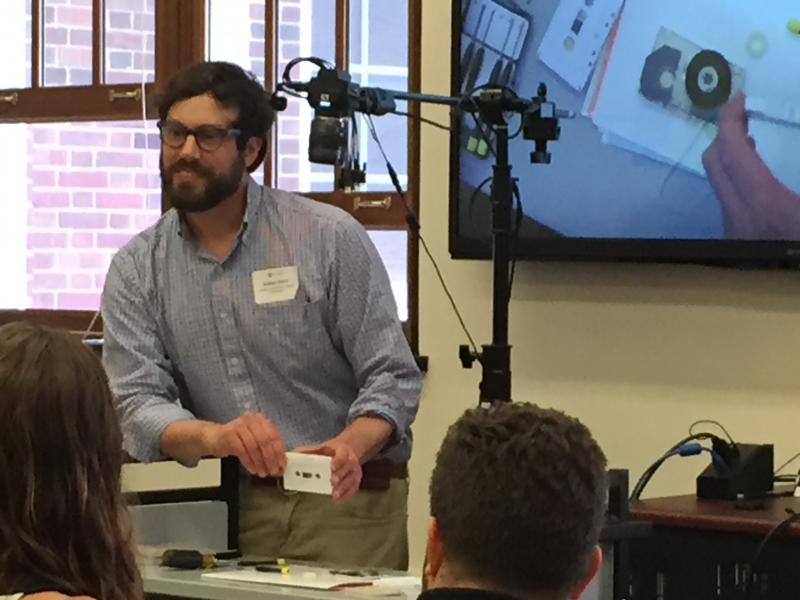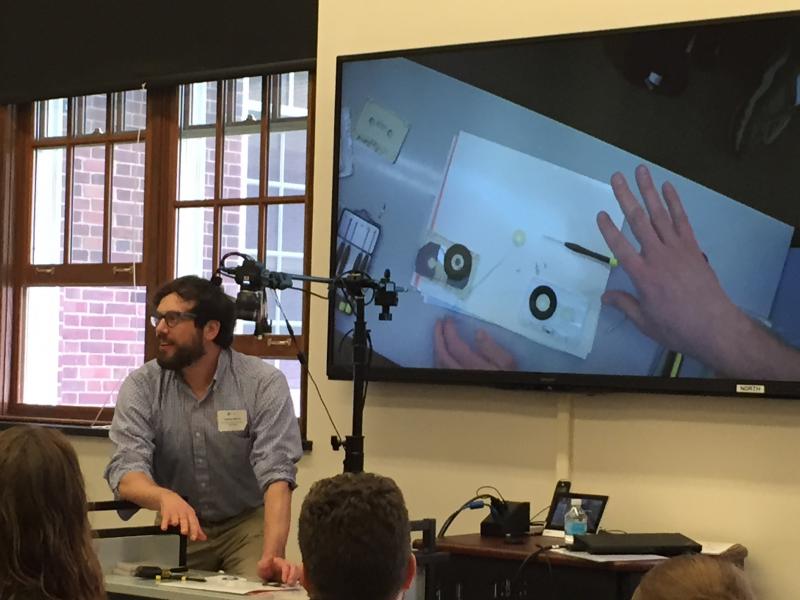A Year in the Life of Audiovisual/Media Preservation in Illinois: Audiovisual Preservation Care & Handling
Miriam Centeno, University of Illinois at Urbana-Champaign
As the culmination of this year-long study on the care of audiovisual materials, the CARLI Preservation Committee sponsored an AV Preservation Workshop held on April 18th, 2016, at the University of Illinois Library at Urbana Champaign. The instructor was Joshua Harris, Media Preservation Coordinator at UIUC. Below are highlights from his presentation. Also, his slides are available and a video recording was made of this workshop.

AV Preservation Workshop Highlights
- Conducting assessment to identify the collections and its condition
- The first step is to know what the institution owns. Nothing can be done until the basic situation of the collection: quantity, location, content & physical condition are known.
- Start by creating a simple spreadsheet to keep the information and add information as it is learned later on.
- Create a preservation plan that addresses the following:
- Proper space and storage conditions
- The ideal situation is to store all the entire media collection from all other materials, not feasible for the majority of collections.
- General Rule: Cool and Low Humidity
- Recommendations:
- Film: 32-54F, 30-50%RH
- CD / DVDs: 40-68F (Room Temp.), 30-50%RH
- Magnetic Tape: 40-54F, 30-50%RH
- There is the need to monitor the temperature & humidity of the spaces available. Establish a baseline for the general condition of the storage area, especially during the changes of the seasons.
- Audiovisual media is best stored vertically on the shelf.
- Avoid storing near heat or water pipes or near electrical conduits that create magnetic charges.
- The ideal situation is to store all the entire media collection from all other materials, not feasible for the majority of collections.
- Setting priorities in the selection for Preservation
- It is best to keep a balance of three areas of prioritization. No one area should come before the other.
- Selection based on content
- In most research environments a librarian or subject specialist is tasked with making decisions regarding content and importance of the content. It is important to be part of the conversation that helps determine priority levels. Conduct searches in databases like World Cat for other libraries holdings can establish rarity or uniqueness. Updates to fellow institutions’ collecting & preservation activities can be found in websites such as of the Association of Moving Image Archivists (they have chat rooms and publications), updates from the Library of Congress for either audio or film.
- Selection based on condition
- Setting the question of content aside, prioritize for condition, addressing first problems such as mold and vinegar syndrome, even before content can be determined, which a basic visual inspection would have caught in the initial assessment. Make a list with notes about the observed issues and segregate from other items in the collection. Determine whether or not an item is worth the cost and labor to remediate or whether to withdraw it. If rare, have the item looked by an expert immediately before it reaches the point of no return.
- Both the presence of mold or vinegar syndrome should propel remediation sooner rather than later, as damage can be catastrophic after a certain point if no human intervention takes place.
- Selection based on risk of obsolescence.
- When faced with unfamiliarity of the format being handled, the Preservation Self-Assessment Program (PSAP) Format ID Guide is an excellent source for identification, especially those formats that are obsolete or are in danger of becoming obsolete. There is also, a direct correlation of obsolete formats to playback equipment. AV preservation is not only about preserving the formats and contents but also the methods that originally made them accessible and are still needed for current and future digitization projects. When in doubt of a machine’s capabilities, seek out a consult through an AV preservation expert or reputable vendor.
- Once the format has been identified (using the PSAP ID Guide), it is safe to assume that if a format type has never been encountered before and there is unfamiliarity with the playback equipment, then there is a good chance that this item is in danger of obsolescence. Selection for preservation due to obsolescence has to be balanced with the other areas of prioritization.
- Selection based on content
- Care & Handling
- Best handling practices
- It is important to have proper training for anybody who is handling media. For circulating materials is good to include a note attached to the enclosure providing handling guidelines for users.
- Circulation staff should be trained to inspect the materials upon return and look for any damage.
- Rehousing needs
- Regardless of the environmental conditions, the most important action that can be taken is to make sure that all media is housed inside a container to keep it protected from temperature & humidity fluctuations and from dust. A non-archival enclosure is better than no enclosure at all. However, make a note to re-house those items when time and budget allow.
- Provide a buffer from environmental conditions.
- Does not need to be archival- use archival enclosures on high value items.
- Appropriate to the format- certain types of housing not appropriate.
- Refer to available knowledgebase resources to see what rehousing is appropriate.
- Also available sources in this topic such as The Film Preservation Guide published by the National Film Preservation Foundation (available for free online) can be useful in the basic and recommended housing for AV materials.
- Even if not able to clean before rehousing, placing the item in an enclosure is better than doing nothing at all.
- Best handling practices
- Disaster Planning & Response
- Disaster Planning
- Follow the disaster plan & prepare for recovery as it is planned for all other materials in the collection. Not all places can differentiate between formats.
- Certain things that can be done in the storage area mitigate/prevent: review the spaces with Facilities, look at what infrastructures run through and around the storage areas and consider whether or not the audiovisual materials should be moved to other locations.
- Contracting with a vendor prior to disaster to secure timely assistance.
- Disaster Response
- If disaster affects a large volume of materials, the recovery vendor needs to be contacted in the first 48 hours.
- Disaster Recovery
- Generally remove items from the disaster area, into a dry space with good ventilation & allow to dry and keep from getting moldy
- In the event of an event, it is important to know what materials are affected and to prioritize which will be recovered first.
- Lay things out to ventilate and air out
- Keep water from remaining stagnant in the media casings.
- Carefully wind film back and forth to air dry
- Disaster Planning
- Funding
- It is difficult to prioritize funding for audiovisual materials. In a research setting media is often seen as less authoritative than textual materials. Institutions see these materials as complicated, their storage as expensive, and are uncertain of the preservation formats (i.e. digital).
- Funding efforts need to overcome the lack of understanding and knowledge about AV material, the difficulty of analyzing the content & accessing the materials without the type of in-depth information existing in print collections.
- Proper space and storage conditions
- Decision making
- What you can do yourself?
- Empower staff in-house
- Create an inventory
- Conduct a visual inspection
- Establish proper rehousing, handling & storage
- Keep building envelope in good working order, collaborating with Facilities in conduction of inspections
- Environmental Monitoring
- When is it time to contact an AV expert?
- Build a network of preservation professionals, knowledgebase printed & online resources and vendors contacts that can provide guidance when questions arise. This will help to determine whether or not the situation requires expert help.
- If working in a small institution, any information that can be provided to a vendor about the nature and the condition of the items selected for treatment will help the vendor better understand what course of action to take that will satisfy the needs of the collection.
- What you can do yourself?

Case Studies - AV Preservation Care & Handling
| Topic | Subtopic | Further Specifics | Anne Thomason, College Archivist and Librarian for Special Collections at Lake Forest College | Patrick Brown, Preservation Librarian at the Morris Library at Southern Illinois University Carbondale |
|---|---|---|---|---|
|
|
|
Sees AV as a part of a larger preservation strategy & makes more sense to work on it as part of Special Collections as a whole. |
Needs to revisit assessment since conditions have changed, and new imminent threats have to be dealt with. |
|
|
|
Considering bringing in someone to see the whole picture. (i.e. looking at the Collections Assessment for Preservation (CAP) Program) |
Agrees with having a more general approach to Preservation |
|
|
Improved storage of audio & video by shifting the materials to sit vertically on shelves. |
A lot of the storage & housing is pretty good from predecessor’s work. |
|
|
|
It is a hard sell to just look at AV materials that are intermingled with other collections – and to prioritize over other materials in the collection |
Priorities -Lots of reel to reel film – will next re-assess collection for signs of degradation and vinegar syndrome |
|
|
Content importance is determined based on patron needs. |
Research & digitization drive prioritization |
||
|
ii. Selection based on condition |
|
See above 2.b |
||
|
But would need to look at reformatting obscure formats |
|
||
|
|
|
|
|
|
|
Comfortable with re-shelling- not that many tapes would need rehousing |
A lot of the storage & housing is pretty good from predecessor’s work. |
|
|
|
|
|
|
|
|
For both institutions, as other priorities and challenges are being met in the current budgetary and staffing climate, soliciting funding for exclusive use for AV materials has to be deferred for the time being. |
||
|
|
|
Can meet with Facilities to see if improvements can be made to the HVAC system, look for ways to save energy- regulating the use of energy, and perhaps moving AV materials to areas that trend cooler than the rest of the building |
|
|
|
Would look for expert services whenever direct intervention is needed, specially of rare & media that needs obscure equipment As well as any large volume migration project of audiocassettes |
|
|
Resources
General AV Care & Handling
Library of Congress. Care, Handling, and Storage of Audio Visual Materials.
Library of Congress. Care, Handling, and Storage of Motion Picture Film.
Connecting to Collections Care Online Community. Caring for Audiovisual Material.
Disaster Planning
Library of Congress. "Model Disaster Recovery Contract." 2011.
Identification & Expert Assessment
Association of Moving Image Archivist Email Discussion List. AMIA-L.
Casey, Mike. "Field Audio Collection Evaluation Tool (FACET): Format Characteristics and Preservation Problems Version 1.0." 2007.
AIC: American Institute for Conservation of Historic and Artistic Works. IMLS and the FAIC Announce New Collections Assessment for Preservation (CAP) Program.
University of Illinois. Preservation Self-Assessment Program (PSAP).
OCLC. WorldCat.org: The World's Largest Library Catalog.
AV Care & Storage by Format
Adelstein, Peter Z. "IPI Media Storage Quick Reference." Rochester, NY: Image Permanence Institute, 2009.
Byers, Fred R. Care and Handling of CDs and DVDs: A Guide for Librarians and Archivists. Washington D.C.: Council on Library and Information Resources and National Institute of Standards and Technology, 2003.
Film Forever: The Home Film Preservation Guide.
Reilly, James M. "IPI Storage Guide for Acetate Film." Rochester, NY: Image Permanence Institute, 1996.
National Film Preservation Foundation. The Film Preservation Guide: The Basics for Archives, Libraries, and Museums. 2004.
Wheeler, Jim. "Videotape Preservaton Guide." 2002.

